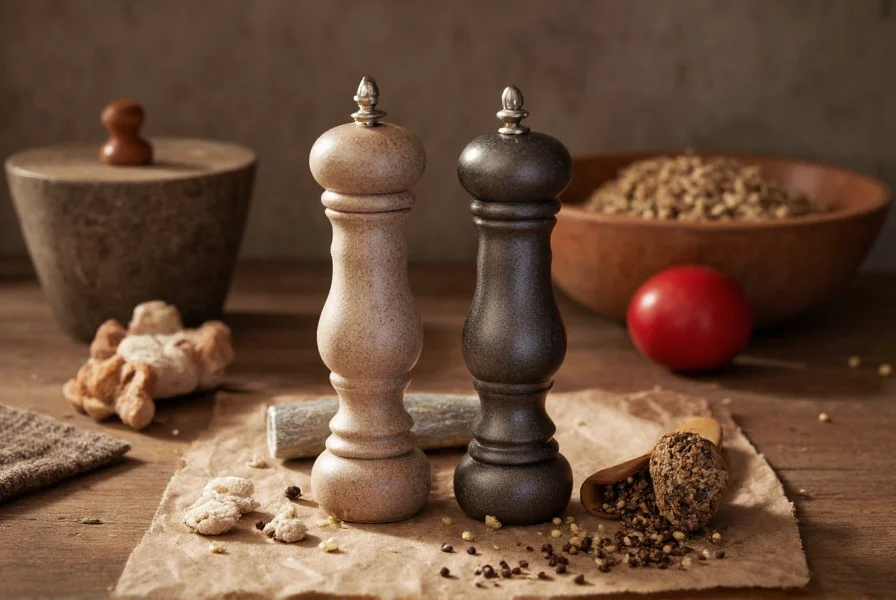When selecting a salt and pepper mill set, understanding the critical components that affect performance and longevity is essential. Many consumers make purchasing mistakes by focusing solely on aesthetics while overlooking the grinding mechanism—the heart of any quality mill. The right set transforms ordinary tableside seasoning into a precise, enjoyable experience that enhances your culinary creations.
Understanding Milling Mechanisms: The Core of Quality
The grinding mechanism determines how effectively your mill processes spices. Unlike cheaper models with plastic components that wear down quickly, premium mills use specialized materials engineered for specific spices:
| Mechanism Type | Best For | Lifespan | Maintenance Needs |
|---|---|---|---|
| Ceramic | Salt, spices, dried herbs | 10+ years | Resistant to corrosion, minimal maintenance |
| Stainless Steel | Peppercorns, whole spices | 8-12 years | Occasional cleaning, avoid moisture |
| Carbon Steel | Peppercorns (traditional) | 5-7 years | Requires thorough drying to prevent rust |
Ceramic mechanisms prove superior for salt mills because they resist corrosion from salt's hygroscopic nature. Stainless steel mechanisms work better for pepper mills as they maintain sharpness when grinding hard peppercorns. Avoid sets using the same mechanism type for both spices—this compromises performance and longevity.
Material Considerations for Salt and Pepper Mill Sets
The housing material affects both aesthetics and functionality. While appearance matters for kitchen decor, certain materials offer practical advantages:
- Wooden mills provide natural insulation against temperature changes that can cause salt clumping. Look for sustainably sourced hardwoods like beech or acacia that resist moisture absorption.
- Stainless steel mills offer durability and modern aesthetics but require attention to prevent salt corrosion at the mechanism housing.
- Acrylic mills showcase spice levels clearly but may develop static that causes fine grounds to stick to surfaces.
When evaluating a salt and pepper mill set for home use, consider your kitchen environment. Humid climates demand more moisture-resistant materials, while frequent entertainers benefit from larger capacity mills that require less frequent refilling.
Essential Features of High-Performance Sets
Professional chefs and home cooks seeking the best salt and pepper mill set identify these non-negotiable features:
Adjustable Grind Settings
The finest sets offer continuous grind adjustment from fine powder to coarse cracks. Look for mills with external dials that allow changes without disassembly. Sets with only 3-5 preset settings often disappoint users seeking precise control for different culinary applications.
Efficient Refilling Systems
Top-loading designs with wide openings simplify refilling compared to bottom-loading models. The best salt and pepper mill sets incorporate magnetic tops or secure twist mechanisms that prevent accidental opening during use while allowing quick access for refilling.
Stable Base Design
Mills that wobble during grinding frustrate users and create inconsistent results. Quality sets feature weighted bases or non-slip bottoms that maintain stability. For tableside service, consider models with wider bases that resist tipping.
Maintenance Practices That Extend Mill Longevity
Proper care significantly extends the life of your salt and pepper mill set. Many users unknowingly damage their mills through improper cleaning methods:
- Never immerse mills in water—moisture damages mechanisms and wooden components
- Dry wiping only with a soft cloth maintains appearance without risking internal damage
- Occasional mechanism cleaning using uncooked rice to absorb moisture and debris
- Wooden mill conditioning with food-safe mineral oil every 6-12 months
Salt mills require particular attention as salt's moisture-attracting properties can cause internal corrosion. If your salt mill becomes difficult to turn, disassemble according to manufacturer instructions and clean the mechanism thoroughly before reassembling.
Common Misconceptions About Salt and Pepper Mills
Several myths persist about salt and pepper mill sets that influence purchasing decisions:
- "All mills work equally well for salt and pepper"—Incorrect. Salt corrodes metal mechanisms, requiring ceramic components.
- "More expensive always means better quality"—Not necessarily. Some mid-range sets offer excellent mechanisms with simpler housings.
- "Electric mills outperform manual ones"—Electric models offer convenience but often lack the precise control of quality manual mills.
- "Larger mills mean less frequent refilling"—Oversized mills expose more spice to air, reducing freshness.
Understanding these realities helps consumers select the best salt and pepper mill set for their specific needs rather than being swayed by marketing claims.
Choosing the Right Set for Your Kitchen
Consider these practical factors when selecting your salt and pepper mill set:
- Frequency of use: Daily users need durable mechanisms, while occasional users might prioritize aesthetics
- Storage space: Countertop sets should complement your kitchen decor; drawer storage requires more compact designs
- Hand strength considerations: Those with arthritis benefit from lighter-turning mechanisms
- Spice variety: If using specialty salts or large peppercorns, verify mill compatibility
The ideal salt and pepper mill set balances performance, durability, and design to become a functional kitchen staple rather than a decorative afterthought. Investing in quality mechanisms pays dividends through years of reliable service and consistent seasoning results.











 浙公网安备
33010002000092号
浙公网安备
33010002000092号 浙B2-20120091-4
浙B2-20120091-4